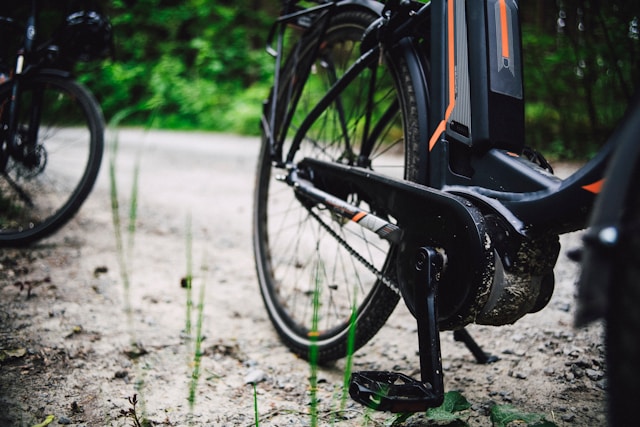Electric bikes, also known as e-bikes, are revolutionizing cycling by making rides easier, more versatile, and accessible to more people. Integrated electric motors provide pedal assistance, letting you coast up hills, headwind battle winds, or carry heavy loads with less effort. Meanwhile, sleek designs, smartphone integration, cargo hauling options, and all-weather durability bring cycling functionally on par with driving for commute and everyday transportation needs.
For recreation too, purpose-built e-MTBs open up trail riding stamina while compact folding e-bikes widen travel possibilities. Whether substituting car trips across town, hauling kids and groceries uphill effortlessly, escaping congested highways for backroad adventures, or simply building fitness confidence on two wheels, e-bikes empower diverse riding goals once hindered by physical fitness, terrain, distances, or convenience factors.
How Do E-Bikes Work?
While pedal power still propels e-bikes, integrated electric components enhance the cycling experience through battery-powered assistance activated by pedaling. Here’s a breakdown of the key parts:
- Electric Motor: Compact brushless motors ranging from 200-750 watts gently engage with the pedal drivetrain, sensing pedal cadence, and speed to determine electric assistance delivering smooth, silent power boosts sensing rider inputs. Motors sit centrally on the hub or bottom bracket.
- Battery: Lithium-ion battery packs ranging from 5 to 15 amp-hours hold charge powering motors, with higher capacity extending per-charge range reaching 50+ miles depending on settings. Batteries easily detach for indoor charging and lock securely on frames against theft.
- Pedal Assist System (PAS): PAS or torque sensors around pedals sync motor engagement with pedaling cadence and force for intuitive, seamless power delivery scaling directly to human input effort. This avoids surging sensations. Riders control assistance amounts (low, medium, high) through handlebar settings.
- Throttle (optional): Twisting throttles like dirt bikes allow riding powered by motor alone without any pedaling up to 20mph, great for launching from stops and climbing steep hills without gassing out. U.S. laws require pedaling engagement occasionally for safety.
Whether you want a sleek road bike with subtle assist hauling you faster and farther or extreme terrain-conquering capabilities opening new adventure possibilities, e-bikes truly offer something for every interested rider type and goal.
Types of E-Bikes
With unique strengths suiting diverse riding needs, key e-bike classifications include:
- Commuter E-Bikes: Optimized for convenient daily transportation needs, these lightweight models feature step-through frames for mounting ease, puncture-resistant tires, bolt-on accessories like cargo racks or fenders, and 250-500 watt range motors assist riding 10-30 miles at 15-20 mph ideal for urban/suburban trips.
- Mountain E-Bikes (E-MTBs): E-MTB models allow aggressive trail riding and challenging uphill climbs without overexertion. Beefy suspension, wide tires, 500-750 watt motors, and rugged frames provide stability, traction, and torque conquering backcountry terrain at speeds around 20mph.
- Cruiser E-Bikes: For casual neighborhood rolls, cruising models supply relaxed rider positioning, cushy saddles, swept-back handlebars, and smaller 200-400 watt hub motors for up to 20-mile jaunts at 15mph. Step-through frames ease mounting for skirts or dresses.
- Cargo E-Bikes: With expanded rear racks, cargo bags, or trailers safely transporting kids, pets, and gear, cargo e-bikes handle heavyweight hauling needs for families and businesses. Stronger frames, 750-watt motors, and 20+ inch wheels provide stability.
- Folding E-Bikes: Collapsing frames, handles, and pedals collapse these ultra-compact models into suitcase sizes in seconds – ideal for RVing campers, boaters, urban commuters wanting portable transport, and public transit riders. Their 20-inch wheels, 250-watt motors, and 9-12 mile range handle last-mile connections with ease.
Benefits of E-Bikes
Compared to traditional bicycles, e-bikes provide key advantages making cycling more practical, comfortable, and fun across transport, fitness, and recreation goals:
- Effortless Travel: Electric-assist conquers challenging hills, headwinds, and distances avoiding overexertion and sweating through shirts before arriving. More people bike commute sticking to eco-goals with e-mobility.
- Increased Exercise: Research shows e-bikers get over 50% more exercise compared to driving while still reducing exertion by 200+ heartbeats per ride. Consistent activity improves cardiovascular health when incorporated into routines.
- Eco-friendly Transport: Replacing gasoline-powered car trips, e-bikes emit zero pollutants. Contrary to stigma, studies show almost 50% of car trips are under 3 miles making them feasible to substitute.
- Reduced Traffic Congestion: Bike commuters help alleviate clogged rush hour highways for fellow commuters still needing vehicle transports based on distance while freeing parking space. This makes city living more livable.
- Cost-Effective: At $500 to $5000 averaged over years, owning and maintaining an e-bike costs a fraction of a car. Saving money motivates many adopters and cost critiques. Insurance and parking also come free!
- Parking Convenience: No circling blocks or parking garages. Simply lock up on any bike rack and enter buildings hassle-free. This saves money while adding exercise.
- Fun & Versatile: Customizable PAS settings, throttles, and swappable batteries extend capabilities mileage-wise. Cargo haulers transfer errands running too. Contemporary style choices widen mainstream appeal.
With advantages spanning affordable eco-commuting, activity improvements, and access envisioning car-free futures, e-bikes make purposeful cycling achievable by diverse populations. Test rides eliminate any skepticism.
Key Considerations When Buying an E-Bike
With ballooning electric bikes stores near me meeting all needs and budgets, keep these key factors in mind when tailoring your perfect electric match:
- Motor Power & Range: Heavier riders and steep terrain demand 500+ watt motors. But the compact 250-350W suburban cruiser range needs only 8-15 mile assist. Know realistic usage and get the appropriate electric boost strength balancing cost. Exchangeable batteries future-proof higher mile capacity when needed.
- Battery: Lithium-ion batteries averaging 10 amp-hours offer a 30+ mile range. Max out capacity extending runtimes if your commute edges range limits. Quick charging USB ports directly attached to downtubes allow topping batteries off immediately before storing bikes.
- Frame Size & Style: Consider wheelbases (triangles rear wheel to handlebars) spanning appropriate heights when flattened for easy mounting/dismounting. Low-top tubes help here. Step-through models also aid swing-through transfers for disability access and riders wearing skirts.
- Brakes: Electric speeds 20-28 mph demand strong hydraulic disc brakes or premium linear pull V-brakes for quick, safe stopping power in all conditions. Integrated lights improve road presence after dark too. Prioritize safety.
- Comfort: Wide tires, adjustable stems, cloudlike gel saddles, and ergonomic grips prevent numbness and pain over long distances. Test rides check proper bike fit adjustments suiting your flexibility and proportions.
- Budget: Prices span from $500 to $5000. Commuter/city run-around starts around $1500, while full-suspension electric mountain bikes approach high-end auto costs. Compare warranty coverage, components quality, ride specialty, and after-sales support when investing.
While the upfront cost exceeds basic bikes, rapidly dropping lithium-ion battery prices make e-bikes most everyday commuter and recreation vehicles a realistic transportation solution with huge upsides versus vehicle driving. Make the switch to empowering electric mobility surpassing limitations holding back your goals. You’ll never look back!
Conclusion
Electric bikes eliminate many barriers keeping people from joyfully riding more often for transportation, fitness, and freedom. Integrated pedal assist eases physical demands while opening exploration possibilities once daunting. Purpose-built e-bike categories meet diverse needs from daily commuting and utilitarian hauling to offroad adventures beyond imagined horizons. Plus, folding packs shrink e-power for RV and boat travelers. Test ride multiple e-bike styles and settings to appreciate their intuitive, empowering benefits firsthand.







